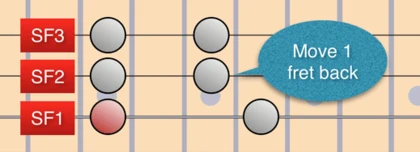Diminished Scales For Guitar
The Diminished scale pattern is made up of a series of alternating half steps and whole steps. On the fretboard a half step corresponds to a distance of one fret, and a whole step is two frets. So when we lay this out on a single string we start on our Root Note and move up one fret, then two, then one again and so on:

Why You Don't Need A Diminished Scale Guitar Tab
Symmetric scales such as this one are very easy to lay out on the guitar fretboard. Watch the video below for an easy and effective way to instantly play the diminished scale in all fretboard positions, using the String Fragment System.
Video: Instant Diminished Scale
What's An Octatonic Scale?
"Octatonic" means that the scale has eight (octa-) notes (-tonic). Most scales have 7 notes (or 5 in the case of pentatonic scales), so when someone refers to an octatonic scale, they are usually talking about the diminished scale, which is the most common 8-note scale.
In the diagram above, count the notes and you will see that this is indeed an 8 note scale. In this example we start on the B root note in fret 2 and it takes 8 notes before we get to the root again (in this case the B in fret 14).
Half-Whole VS Whole-Half Diminished Scales
If we begin with a half step followed by a whole step, the scale is called a "Half Whole Diminished Scale"
If we begin with a whole step instead of the half step, the it's called a "Whole Half Diminished Scale"
These two scales are essentially modes of each other and are collectively called the "Symmetric Diminished Scale”.
Actually all structures that are made of repeating interval groups are called “Symmetric Structures”, and if we are talking about scales they are called “Symmetric Scales”. We will look at more of these in another lesson.
How To Play The Diminished Scale
As you will quickly figure out, it’s very impractical to play this scale on a single string. It can be cool to do it sometimes, maybe combined with sliding as a special effect, and so on, but we need to find a way to play this on more than one string in order to improvise with it freely and mix it up with other scales.
And once again, instead of having you memorize meaningless scale shapes, I will show you an application of SFS (String Fragment System) that will get you going with this scale immediately.
This is not the only option, and I will make other lessons later that cover all diminished fingerings, but this is the quickest one, because the whole system is just one string fragment.
That's right! In a few seconds you will be able to play this scale everywhere on the fretboard using just one string fragment. Here it is:

And here's how to use it to build the complete scale; First you place your first finger on the root note and play these 4 notes. In the following example I use the A on fret 5 as a Root Note:

Then you move one fret up and repeat the same string fragment:

Then one up again and repeat:

You then continue in the same way, but as always with SFS there is an exception when crossing between strings 3 and 2. You will have to move up 2 frets at that point. So we end up with this fingering shape, which conveniently covers a wide range by moving diagonally:

Now it doesn’t matter what string you start with, or what key you play in. You will always get the same system. That’s the beauty of SFS. So what you need to do now is to play through these scale a few times, decide what fingers you want to use, get some muscle memory happening, and so on.
Then you can use the backing track below and improvise creatively with it in the key of A. Make sure that you build the scale on every A on the fretboard just like we do with the pentatonic scales.
In the video I play a demo, going through the following practice routine that you can use in your own practice sessions as well:
Build the system in the ASCENDING direction, on every string, starting on the A
Build the system in the DESCENDING direction, on every string, starting on the A
Improvise freely and jump between fretboard areas, again using the A as a root note.
Practice this yourself and when you feel that you are beginning to get comfortable with it, then you can move on to the next lesson where we will talk about where you can use this scale, and how you can mix it with your pentatonic scales in songs with complex chord changes.

